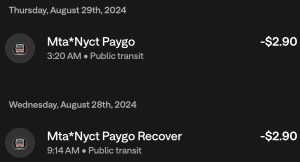
A brisk walk to the train station–just three minutes away from home, Viannly Concepcion wears her puffy jacket and comfy sneakers before braving the cold winds of the city’s winter climate. She attends City College of New York, in Harlem, just a few train stops from her home. The icy wind doesn’t disturb her peace for long. Heading down the station steps, she takes out her OMNY card from her wallet. As she presses it on the card reader, the machine’s screen flashes green, and she’s let through.
Later that night, her phone buzzes. A notification shows her card was charged not just once, but twice–on some occasions, even three times. She finds it surprising, but it’s not the first time this has happened.
“When I started tapping, I realized that it wouldn’t charge me right away, but instead it would double or triple charge me at midnight,” said Concepcion as she recounted her story.
The MTA’s OMNY card launched to the public on May 31, 2019, with machines being installed at 16 subway locations and on Staten Island buses as part of the MTA’s pilot program. It wasn’t fully integrated into train stations until the end of 2020, clearly signaling it would replace New York City’s traditional MetroCard. This payment overhaul followed a long history of fare evolution, dating back to 1904 when New Yorkers paid with nickels.
When OMNY was introduced, New Yorkers were told it would be a more elevated version of the yellow, blue and black plastic MetroCard–offering convenience, affordability, and one less swipe to worry about.
Now, in 2025, Concepcion isn’t the only New Yorker dealing with this similar issue. Josh Morales, a Hunter College student, notes that on some occasions his OMNY card doesn’t allow him to use his transfer, even within the time limit the MTA offers.
“While I am kinda pissed, I don’t have the time to do a whole research about it,” said Morales when asked about finding a possible solution.

Others have taken to social media to share frustrations about OMNY. Many complained about being charged multiple times at odd hours and said attempts to report the issue only led to more questions than answers. Some of the videos go back to 2022, just two years after OMNY was fully implemented into stations.
In one instance, a TikToker posted a video that received more than 66,000 views. In it, they recount a call with an MTA official about false transactions, listing locations on specific days they hadn’t visited.
“How did your system charge me for things I didn’t pay for?” the TikToker asked.
After discovering she wasn’t alone, Concepcion decided she no longer wanted her money “stolen.” Upon seeing more videos online, however, she didn’t know what else to do.

“I came across a couple of people experiencing the same issue of telling their experience about how they barely get any help from the [MTA] workers to get their money back or a way to not get their money just taken away like that,” said Concepcion.
In response to a question about the payment shift, Joana Flores from the MTA Press Office said, “Every year, there is about $40 million of fare value underutilized from weekly and monthly Metrocards. With the fare-capping feature of the tap-and-go payment method, customers are saving themselves the guessing game from overspending on a fare product they won’t optimally use, and keeping more money in their pockets.”
Initially, OMNY did have a positive reaction from the public. It didn’t require users to preload a specific balance, allowing people to pay however much they needed at the moment. It also introduced the “12-ride” feature–after 12 paid rides in a week, the next rides are free for the rest of the 7-day period, similar to an unlimited pass without the upfront purchase.
Compared to OMNY, MetroCards seemed to be more of an inconvenience. According to an MTA press release, MTA Chair and CEO Janno Lieber said, “Tap-and-go-already the choice for 65% of our riders–is not only easier and more convenient to use, it also opens the door for new discounts and promotions that’ll put money back in riders’ pockets.”
With the contactless system, the MTA is expected to save $20 million in annual operating savings with no worry in production and distribution costs; vending machine repairs; cash collection and handling. The OMNY fare system will also provide “special deals” for tourists and a possible loyalty program in the future–similar to airline frequent-flyer programs. It’s also expected to aid the MTA in tracking fare compliance across New York City and reduce fare evasion.
Although Concepcion, the City College student, initially liked OMNY’s tap-and-go function, she now says MetroCard inconveniences no longer bother her anymore. She simply wants her money back.









